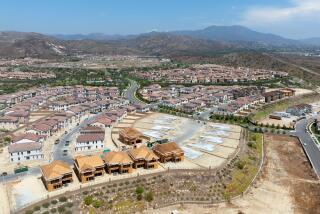Inland growth to continue
Despite skyrocketing foreclosure rates and a sluggish economy, the Inland Empire will remain the fastest-growing region of the state in the years ahead as more people flee high-priced coastal areas, according to a study released this week.
“The Inland Empire will continue to be the locus of growth in California as it has been in the past,” said Hans Johnson, director of research for the Public Policy Institute of California, a nonpartisan group that conducted the study. “Traditionally it has been at the epicenter of booms and busts, and there undoubtedly will be a recovery.”
By 2015 the population of Riverside and San Bernardino counties is projected to increase by a million people, bringing it to 5 million. By then, the demographics of the region are also expected to change, with Latinos making up the majority at 51%, up from 43% now. The number of Asians is expected to grow from 5% to about 7% of the population overall and about 10% in southwest Riverside County.
The study predicts that the current economic downturn will temporarily slow growth but not stop it. Affordability will remain the draw as people continue to move inland, where they can afford homes.
Yet as newcomers pour in, serious problems will remain. The Inland Empire is one of the least educated regions of the state, and that’s not likely to change soon.
The number of adults with bachelor’s degrees is expected to rise only from 19% to 21% by 2015, Johnson said.
“There has been a slight decline in people who haven’t graduated high school, from 1 in 5 to 1 in 4, but the increase in bachelor’s degrees will be pretty low and lag behind the rest of the state,” he said.
The result will be many people working at the lower end of the economy, as well-paying jobs increasingly demand college degrees. As a consequence, the study said, wages in the Inland Empire are expected to remain far below those in other parts of the nation. A 2006 study looking at salaries in 51 metropolitan areas of the country ranked the Inland Empire next to last, with an average annual wage of $36,924.
“We hope there will be an effort to provide training programs for employees to address these issues,” Johnson said.
The areas with the highest population growth potential include the San Jacinto Valley and southwest Riverside County.
Johnson said the San Jacinto Valley, which includes Beaumont, Banning, Hemet and Calimesa, will grow by 4.5% a year. The population will rise from 232,000 to 310,000 by 2015.
Southwest Riverside County, which takes in Temecula, Murrieta, Menifee and Lake Elsinore, could add 150,000 people.
Johnson said 70% of projected growth will result from a migration of people from bordering counties, especially Los Angeles County.
Cheap housing and plentiful land have long fueled Inland Empire expansion. The region has grown 50% since 1990, double the rate of the rest of California. Once-sleepy communities including Temecula have gone from populations of 27,000 to nearly 100,000.
At the same time, the mortgage crisis has hit the area hard. Thousands of homeowners have defaulted on their loans, and builders have slashed prices to attract buyers.
“The rate of growth will be slower, but it is still strong and has high numbers,” Johnson said. “Southern California continues to be an attractive place to live, and job creation will be strong.”
Riverside County Supervisor John Tavaglione said he believed his county was “as prepared as we can be, recognizing that the infrastructure is way behind the curve in California.”
“What is most concerning is the disconnect between education and higher-paying jobs,” he said. “We need to do a better job in creating a more highly educated workforce.”
Tavaglione said few of the study’s findings surprise him.
“Whether we believe it’s good or bad doesn’t matter -- it’s inevitable,” he said of the projected growth. “The best we can do as public officials is try to create quality of life as far as schools, parks and open space. With growth comes tremendous prosperity. We were among the last to see the economy slow down, and I think we will be the first to see it turn around.”
Johnson said he agreed with the assessment that education remains a serious problem in the Inland Empire. At the same time, he said, the area remains among the last bastions of affordable living in California.
“The optimistic view is the Inland Empire will still serve as a region people want to move to,” he said. “The housing is cheaper, they can have more space and they don’t have to live in some cramped condo on the coast. That’s part of the American dream.”
---
More to Read
Sign up for Essential California
The most important California stories and recommendations in your inbox every morning.
You may occasionally receive promotional content from the Los Angeles Times.










